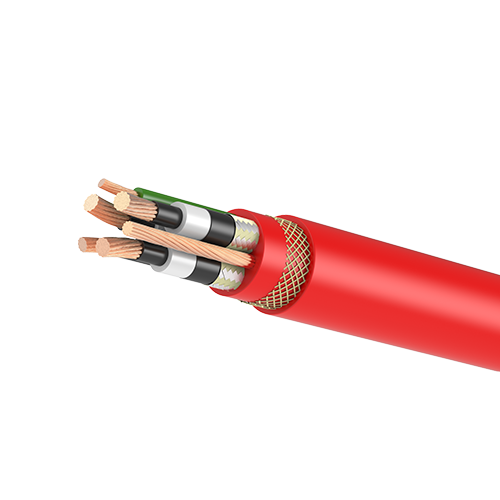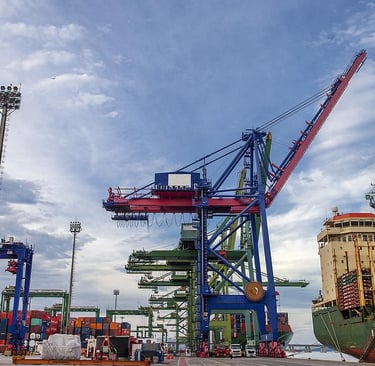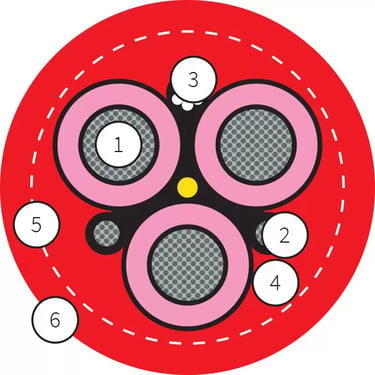📞+86 153 7530 2641 📧 hongjing.Wang@feichuncables.com
AS/NZS 3191 Compliant Port Crane Cable: Safety & Standards Guide
Discover how AS/NZS 3191 compliant port crane cable ensures marine-grade safety, durability, and performance in Australia’s harsh port and reeling systems.
hongjing.Wang@Feichun
7/11/20256 min read
Introduction
Australia's bustling ports handle millions of tonnes of cargo annually, with sophisticated port cranes serving as the backbone of maritime operations. These massive machines, including ship-to-shore cranes and rail-mounted gantry cranes, operate in demanding environments where reliable electrical systems are absolutely critical. The electrical needs of port cranes are complex and challenging, requiring robust power delivery systems that can withstand the harsh marine environment whilst supporting heavy loads and dynamic movement patterns.
Port cranes must operate continuously under extreme conditions, from the scorching heat of summer to the corrosive salt spray that characterises Australia's coastal ports. The importance of electrical standards cannot be overstated in these environments, as they ensure equipment safety, minimise costly downtime, and guarantee compliance with stringent regulatory requirements. Without proper standards, port operations could face significant disruptions, safety hazards, and regulatory penalties.
The relevance of AS/NZS 3191 in this context is paramount. This comprehensive standard provides detailed guidance for electrically flexible cables used in port cranes, ensuring their performance and safety under the most demanding operational conditions. By adhering to AS/NZS 3191 specifications, port operators can maintain reliable crane operations whilst protecting their investment in critical infrastructure.


What is AS/NZS 3191?
AS/NZS 3191 is the definitive Australian and New Zealand standard titled "Electrically Flexible Cables," which establishes comprehensive specifications for the construction, dimensions, and testing requirements of flexible cables suitable for various industrial applications. This standard serves as the benchmark for AS/NZS 3191 compliant port crane cable systems throughout Australia and New Zealand.
The standard has a rich history, having originated from AS C50 in 1928, evolving through decades of technological advancement and practical experience. The latest version is the 2008 edition, which was reaffirmed in 2019, incorporating modern safety requirements and technological improvements. This evolution reflects the changing needs of Australian industry and the continuous improvement of electrical safety standards.
The primary purpose of AS/NZS 3191 is to ensure the safety and performance of flexible cables across a wide range of voltage levels, up to 0.6/1 kV, and under various environmental conditions. This comprehensive approach makes it particularly suitable for the demanding requirements of port crane applications, where cables must perform reliably in harsh marine environments.
Key Requirements of AS/NZS 3191
The construction requirements under AS/NZS 3191 are rigorous and specific. Cables must utilise high-quality insulation materials such as thermoplastic or cross-linked PVC, cross-linked elastomers, or cross-linked polyolefins. These materials are carefully selected to suit light, medium, and heavy-duty applications, with heavy-duty flexible cable for Australian ports requiring the most robust specifications.
Dimensional requirements are equally stringent, covering conductor size, insulation thickness, and jacket requirements to ensure both mechanical and electrical integrity. These specifications guarantee that marine-grade reeling cable for container terminals can withstand the constant flexing and environmental stresses encountered in port operations.
The standard supports various voltage levels, including 250/250 V, 250/440 V, and 0.6/1 kV configurations, making it suitable for the heavy-duty electrical needs of modern port cranes. This flexibility allows engineers to select AS/NZS standard cable for crane power systems that precisely match their operational requirements.
Testing requirements are comprehensive and include mechanical testing such as bending and tensile strength assessments, electrical testing including insulation resistance verification, and environmental testing covering heat resistance and chemical resistance. These rigorous testing protocols ensure that flexible PVC insulated cable for port cranes can withstand Australia's harsh operating conditions.
Applications for Port Crane Cables
The importance of flexible cables in port crane operations cannot be understated. Moving parts of port cranes, including booms, tackle systems, and rotating mechanisms, require AS/NZS 3191 flexible control cable for marine use that can accommodate constant dynamic operations without failure. These cables must flex thousands of times daily whilst maintaining electrical integrity and safety standards.
Suitable cable types under AS/NZS 3191 include heavy-duty multi-core PVC or XLPE insulated cables, specifically designed for power and control circuits in port cranes. These crane cable solutions for corrosive port environments are engineered to withstand the unique challenges posed by salt spray, extreme temperatures, and mechanical stress.
Practical applications include providing reliable power to moving parts of cranes, ensuring that massive loads can be lifted and positioned safely. Control circuits utilise these cables to ensure precise operation of crane movements, with safety systems depending on reliable electrical connections. Additionally, communication and monitoring systems rely on these cables to maintain operational oversight and safety protocols.
Environmental considerations are critical in Australian ports, where seawater exposure, extreme weather conditions, and significant mechanical stress are constant challenges. AS/NZS 3191 ensures that industrial-grade PVC cable for offshore and port cranes can withstand these harsh conditions, maintaining performance and safety over extended operational periods.


Ensuring Compliance with AS/NZS 3191
Cable selection criteria are fundamental to achieving compliance. Engineers must choose appropriate cable types, such as 0.6/1 kV heavy-duty cables, based on the specific voltage requirements of crane systems. This selection process must also ensure that cables meet the current carrying capacity requirements specified in AS/NZS 3008.1, creating a comprehensive electrical safety framework.
Installation best practices are crucial for long-term performance. Proper cable routing prevents excessive bending or mechanical damage, whilst protective sleeves provide additional durability in high-wear areas. Professional installation by qualified technicians ensures that port machinery cable compliant with AS/NZS standards performs as intended throughout its operational life.
Maintenance and inspection protocols are essential for continued compliance. Regular inspections must identify signs of wear, corrosion, or insulation damage before they compromise safety or performance. Following manufacturer maintenance guidelines ensures that cables continue to meet AS/NZS 3191 requirements throughout their service life.
Periodic inspection and maintenance programmes should include regular electrical and mechanical testing to ensure continued compliance with standards. This proactive approach prevents unexpected failures and maintains the safety and reliability that AS/NZS 3191 is designed to provide.
Case Studies and Real-World Applications
Case Study 1: Ship-to-Shore Cranes in Australian Ports
A major Australian port implemented AS/NZS 3191 compliant heavy-duty PVC-insulated cables for their ship-to-shore crane fleet. The project involved replacing aging cable systems with modern AS/NZS 3191 cable supplier solutions specifically designed for Australia's demanding port environment.
The results were impressive, with significantly reduced downtime due to cable failures and improved operational efficiency. The marine-grade cable systems demonstrated superior performance under the constant flexing and harsh environmental conditions typical of container terminal operations.
Case Study 2: Rail-Mounted Gantry Cranes in New Zealand Ports
A New Zealand port facility adopted XLPE-insulated cables compliant with AS/NZS 3191 for their rail-mounted gantry cranes operating in harsh coastal environments. The initial challenge involved improper cable routing during installation, which resulted in premature wear and potential safety concerns.
The solution involved optimising cable routing paths and implementing proper support systems, demonstrating the importance of professional installation practices. The project ultimately succeeded in providing reliable power delivery systems that met all AS/NZS 3191 requirements.
Benefits of AS/NZS 3191 Compliance
The benefits of implementing AS/NZS 3191 compliant systems extend far beyond mere regulatory compliance. Improved safety represents the primary advantage, with reduced risk of electrical incidents protecting both personnel and equipment. This enhanced safety profile is particularly important in port environments where multiple hazards exist simultaneously.
Meeting regulatory requirements in Australia and New Zealand ensures smooth operations without compliance-related disruptions. Port operators can focus on their core business activities, confident that their electrical systems meet all applicable standards and regulations.
Extended cable life and reduced maintenance costs provide significant economic benefits. Quality AS/NZS 3191 compliant cables typically offer longer service life and lower total cost of ownership compared to non-compliant alternatives, making them a wise investment for port operators.
Frequently Asked Questions
Q: What makes AS/NZS 3191 cables suitable for marine environments?
A: AS/NZS 3191 cables are specifically designed with marine-grade insulation materials and protective jackets that resist salt spray, moisture, and UV exposure. The standard includes rigorous environmental testing requirements that ensure cables can withstand the corrosive conditions found in Australian ports.
Q: How often should AS/NZS 3191 compliant cables be inspected?
A: Regular visual inspections should be conducted monthly, with comprehensive electrical testing performed annually. However, inspection frequency may need to increase based on operating conditions, cable age, and manufacturer recommendations.
Q: Can existing non-compliant cables be retrofitted to meet AS/NZS 3191?
A: Generally, cables cannot be retrofitted to meet AS/NZS 3191 standards. The standard requires specific construction materials and methods that must be implemented during manufacturing. Upgrading typically requires complete cable replacement with compliant products.
Q: What are the consequences of using non-compliant cables?
A: Using non-compliant cables can result in safety hazards, regulatory penalties, increased maintenance costs, and potential equipment damage. Insurance coverage may also be affected if non-compliant cables contribute to incidents or failures.
Conclusion
AS/NZS 3191 compliant port crane cables represent the gold standard for electrical safety and performance in Australia's demanding port environments. By understanding and implementing these standards, port operators can ensure safe, reliable, and efficient crane operations whilst meeting all regulatory requirements. The investment in compliant cable systems pays dividends through reduced downtime, enhanced safety, and long-term operational reliability.
For port operators seeking to maintain competitive advantage whilst ensuring safety and compliance, AS/NZS 3191 compliant cables are not just recommended—they're essential. The standard continues to evolve with technological advances, ensuring that Australian ports remain equipped with the finest electrical infrastructure for continued success in global maritime trade.
How to Reach Us
Get in Touch
SiteMap
Product Catalogue
Reeling Cable
Festoon Cable
Shore Power Cable




Scan to add us on WeChat


